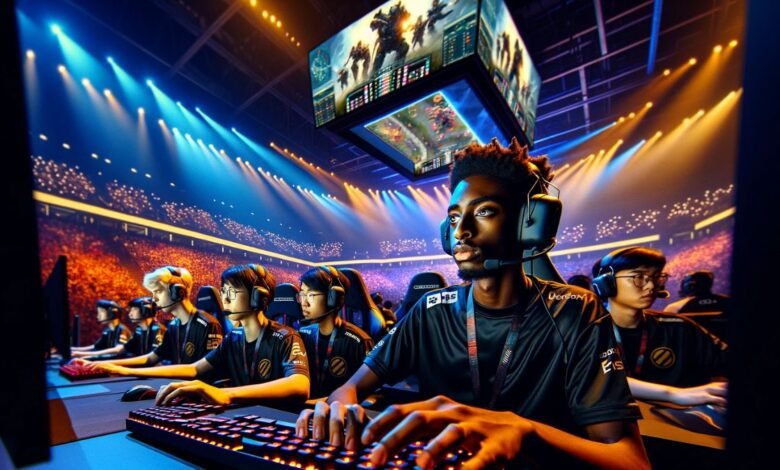The Rise of Mobile eSports: Competitive Gaming on the Go

In the rapidly evolving world of competitive gaming, the rise of mobile eSports has become a notable trend, transforming the landscape of how competitive games are played and enjoyed. As smartphones and tablets continue to advance in both performance and capabilities, mobile eSports has emerged as a dynamic and rapidly growing sector within the broader eSports industry. This article delves into the factors driving this rise, the unique characteristics of mobile eSports, and the implications for both players and the industry as a whole.
The Evolution of Mobile Gaming
The trajectory of mobile gaming has been marked by significant advancements in technology and design. Early mobile games were relatively simple and limited in scope, often constrained by the hardware capabilities of early mobile devices. However, the advent of powerful smartphones with high-resolution screens and robust processors has paved the way for more complex and engaging games. This evolution has not only expanded the variety of games available but also significantly improved their quality, enabling a more immersive experience.
The introduction of high-performance mobile devices has enabled developers to create games that are not just casual pastimes but full-fledged competitive platforms. Graphics have become more sophisticated, and gameplay mechanics have evolved to support complex strategies and rapid reflexes. This progress has set the stage for the emergence of mobile eSports as a serious competitor to traditional gaming platforms like PC and console.
The Growth of Mobile eSports
The growth of mobile eSports has been nothing short of explosive. Several key factors contribute to this rapid expansion, including accessibility, affordability, and the increasing sophistication of mobile devices. Unlike traditional gaming setups, which often require expensive hardware and dedicated gaming spaces, mobile eSports can be played anywhere and on devices that are more affordable and widely available.
One of the most significant drivers of mobile eSports’ growth is the accessibility it offers. Mobile games are available to a vast audience, including those who may not have access to high-end PCs or gaming consoles. This democratization of gaming means that a larger pool of players can participate in competitive gaming, leading to a broader and more diverse player base. Additionally, the ability to play on the go—whether on a commute, during a break, or from the comfort of home—adds a level of convenience that traditional gaming setups cannot match.
Moreover, the rise of mobile eSports has been fueled by the increasing investment from both developers and sponsors. Major game publishers are recognizing the potential of mobile platforms and are investing heavily in creating and promoting mobile eSports titles. This has led to the development of high-profile tournaments and leagues specifically tailored for mobile games, attracting both players and spectators from around the world.
Key Players and Games in Mobile eSports
Several games have emerged as frontrunners in the mobile eSports arena, showcasing the diverse range of genres and gameplay styles that are gaining traction. Titles such as “PUBG Mobile,” “League of Legends: Wild Rift,” “Free Fire,” and “Arena of Valor” have become popular not just for their engaging gameplay but also for their competitive potential.
“PUBG Mobile,” for instance, has made a significant impact on the mobile eSports scene with its battle royale format, offering a competitive experience that mirrors its PC counterpart. The game’s large-scale maps, tactical gameplay, and regular updates keep players engaged and competitive.
Similarly, “League of Legends: Wild Rift” brings the beloved “League of Legends” franchise to mobile devices, allowing players to experience the complex strategies and team dynamics of the original game in a more accessible format. Its competitive scene has quickly grown, with numerous tournaments and leagues being organized around the world.
“Free Fire” and “Arena of Valor” are also notable for their popularity and competitive play. “Free Fire” is known for its fast-paced gameplay and shorter match durations, making it well-suited for mobile play. “Arena of Valor,” on the other hand, offers a multiplayer online battle arena (MOBA) experience that has been optimized for mobile devices, featuring a diverse roster of heroes and strategic gameplay.
These games represent just a fraction of the growing list of mobile eSports titles, each contributing to the overall expansion of the sector. The success of these games highlights the potential for mobile platforms to support competitive gaming on a large scale.
The Competitive Landscape and Tournaments
The competitive landscape of mobile eSports is rapidly evolving, with numerous tournaments and leagues emerging to cater to the growing number of players and fans. Major tournaments such as the PUBG Mobile Global Championship, the Free Fire World Series, and the Arena of Valor International Championship offer substantial prize pools and attract top-tier talent from around the globe.
These tournaments are not only a testament to the popularity of mobile eSports but also an indication of its professionalization. Teams and players are now dedicating significant time and resources to training and competing at the highest level. The rise of professional mobile eSports organizations has led to the development of structured leagues, coaching staff, and extensive support systems for players.
The presence of major sponsors and media coverage further underscores the legitimacy and growing importance of mobile eSports. Companies across various industries are recognizing the value of associating with mobile eSports events, leading to increased investment and visibility for the sector. This growing interest from sponsors has also contributed to the overall professionalization of the scene, with higher production values and more polished event experiences.
Challenges and Opportunities in Mobile eSports
Despite its rapid growth, mobile eSports faces several challenges that need to be addressed for continued success. One of the primary challenges is the fragmentation of the mobile gaming market. With a multitude of devices and operating systems, ensuring compatibility and optimal performance across all platforms can be complex. This fragmentation can also affect the uniformity of competitive play, as performance may vary depending on the device used.
Another challenge is the issue of mobile game control schemes. While touchscreens have come a long way, they still face limitations compared to physical controllers or keyboards and mice. This can impact the precision and speed required for competitive play, particularly in genres that rely heavily on fast reflexes and precise inputs.
Despite these challenges, there are also significant opportunities for growth and innovation in mobile eSports. The continuous advancement of mobile technology holds promise for improving game performance and control. Developers are constantly exploring new ways to enhance the gaming experience, such as integrating external controllers or optimizing games for different hardware configurations.
The global reach of mobile eSports also presents opportunities for expanding into new markets and demographics. As mobile devices become more prevalent worldwide, the potential for growth in regions that have traditionally been underserved by the gaming industry is substantial. This global reach allows for a more diverse and inclusive competitive scene, with players from various backgrounds and regions contributing to the overall growth of the sector.
The Future of Mobile eSports
Looking ahead, the future of mobile eSports appears promising and full of potential. As technology continues to advance, we can expect even more sophisticated and engaging mobile games that push the boundaries of what is possible on handheld devices. The growth of 5G networks is also likely to play a crucial role in shaping the future of mobile eSports, offering faster and more reliable connections that enhance online play and streaming experiences.
Additionally, the integration of augmented reality (AR) and virtual reality (VR) technologies into mobile gaming could open up new avenues for competitive play. These technologies have the potential to create immersive and innovative experiences that could redefine the mobile eSports landscape.
The continued investment from developers, sponsors, and media partners will also be key to sustaining the growth of mobile eSports. As the sector becomes more established, we can expect to see more professional teams, larger tournaments, and increased support for players. This professionalization will contribute to the overall legitimacy and appeal of mobile eSports, attracting more players and fans to the scene.
In conclusion, the rise of mobile eSports represents a significant shift in the competitive gaming landscape. With its accessibility, affordability, and rapid technological advancements, mobile eSports has carved out a prominent place in the industry. As the sector continues to grow and evolve, it will undoubtedly play an increasingly important role in shaping the future of competitive gaming. Whether you are a player, a fan, or an industry professional, the rise of mobile eSports offers exciting opportunities and a glimpse into the future of gaming on the go.



